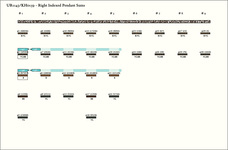| Statistics: |
Original Name: AS143
Original Author: Marcia & Robert Ascher
Museum: Museum für Völkerkunde, Berlin, Germany
Museum Number: VA47096
Provenance: Unknown
Region: Ica
|
# of Cords: 30 (30p)
# of Unique Cord Colors: 6
Benford Match: 0.9114
# Ascher Sums (pps, ips, cps, sps,...): 5 (0, 2, 3, 0,...)
Similar Khipu: Previous (UR1120) Next (AS004)>
|
|
| Notes: |
Ascher Databook Notes:
- This is one of several khipus acquired by the Museum in 1907 with provenance Ica. For a list of them, see UR1100.
- By spacing, the khipu is separated into 2 parts. The first part is 5 groups of 4 or 5 pendants each and the second part is 4 groups of 2 pendants each.
- In part 1:
- Each group has the same 5-color pattern: B:YG, BB:YG, B, BB,YG. Where there are only 4 pendants, it is the 4th position that is non-existent.
- The values in the first group are the sums, position by position, of the values in the other 4 groups.
- The values within each group have the same relative magnitudes. Specifically
Pi3 > Pi1 > Pi5 > Pi2 > Pi4 for i=(1,2,3,4,5)
- From group to group, corresponding positions have the same relative magnitudes. With 1 exception
P1j > P4j > P3j ≥ P5j > P2j for j=(1,2,3,4,5)
- In part 2:
- Each group has the same 2-color pattern: B:YG, BB:YG. These are the first 2 colors of the 5-color pattern of part 1.
- Every value is less than the values in part 1.
- The value on pendant 3 (97357) is probably the largest value on any khipu in this Databook.
|





